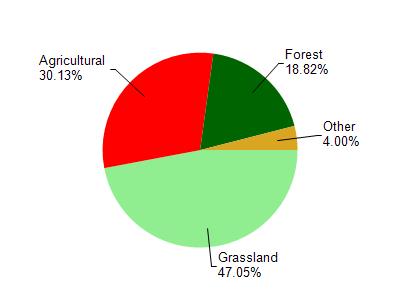Lafayette
No
No
No
Fish and Aquatic Life
Historical Description
Source: 1967, Surface Water Resources of Lafayette County Yellowstone Lake, T3N, R4E, Sections 35, 2, 1 Surface Acres = 455.0; S.D.F = 1.2; Maximum Depth = 21 ft Yellowstone Lake is an impoundment on the Yellowstone River in the northeastern corner of the county. It was one of the first impoundments constructed by the State of Wisconsin. The gates in the dam were closed in 1954. The dam structure was designed to raise the level of the Yellowstone River 23 feet behind nearly a quarter of a mile of dike to create an impoundment 1.9 miles long and 0.6 miles wide. This is a shallow, irregular body with generally steep shores except for the gradual slopes of its upstream end and the bay areas of the south shoreline. The west contains three islands, has a maximum depth of eight feet and a highly irregular bottom plain of barely submerged wooded knolls. The east end averages 12 feet in depth over a generally uniform basin. The original Yellowstone River channel conforms closely with the configurations of the south shoreline. The land area around the lake is completely state-owned and totals 2,217.
Date 1967
Author Surface Water Inventory Of Wisconsin
Impaired Waters
Yellowstone Lake (WBIC 903700) was placed on the impaired waters list for total phosphorus 2014. The 2018 assessments showed continued impairment by phosphorus; new total phosphorus and chlorophyll-a sample data exceeded the 2018 WisCALM listing thresholds for the Recreation use and Fish and Aquatic Life use. Based on the most updated information, no change in the existing impaired waters listing was needed.
Date 2017
Author Ashley Beranek
Impaired Waters
Yellowstone Lake (903700) was placed on the impaired waters list for total phosphorus 2014. The 2016 assessments showed continued impairment by phosphorus; total phosphorus sample data overwhelmingly exceed 2016 WisCALM listing thresholds for the Recreation use, exceeded Fish and Aquatic Life use, and chlorophyll data exceeded REC and FAL thresholds. Based on the most updated information, no change in existing impaired waters listing is needed.
Date 2015
Author Aaron Larson
Condition
Wisconsin has over 84,000 miles of streams, 15,000 lakes and milllions of acres of wetlands. Assessing the condition of this vast amount of water is challenging. The state's water monitoring program uses a media-based, cross-program approach to analyze water condition. An updated monitoring strategy (2015-2020) is now available. Compliance with Clean Water Act fishable, swimmable standards are located in the Executive Summary of Water Condition in 2018. See also the 'monitoring and projects' tab.
Reports
Recommendations
Partnership Project
Southwest Badger Resource Conservation & Development Council, Inc.in cooperation with Natural Resources Conservation Service (NRCS) and the WI Department of Natural Resources (DNR) will significantly reduce the amount of sediment and nutrients entering Yellowstone Lake through installation of conservation best management practices (BMPs).
Best Management Practices, Implement
Southwest Badger Resource Conservation & Development Council, Inc.in cooperation with Natural Resources Conservation Service (NRCS) and the WI Department of Natural Resources (DNR) will significantly reduce the amount of sediment and nutrients entering Yellowstone Lake through installation of conservation best management practices (BMPs).
Management Goals
Wisconsin's Water Quality Standards provide qualitative and quantitative goals for waters that are protective of Fishable, Swimmable conditions [Learn more]. Waters that do not meet water quality standards are considered impaired and restoration actions are planned and carried out until the water is once again fishable and swimmable
Management goals can include creation or implementation of a Total Maximum Daily Load analysis, a Nine Key Element Plan, or other restoration work, education and outreach and more. If specific recommendations exist for this water, they will be displayed below online.
Monitoring
Monitoring the condition of a river, stream, or lake includes gathering physical, chemical, biological, and habitat data. Comprehensive studies often gather all these parameters in great detail, while lighter assessment events will involve sampling physical, chemical and biological data such as macroinvertebrates. Aquatic macroinvertebrates and fish communities integrate watershed or catchment condition, providing great insight into overall ecosystem health. Chemical and habitat parameters tell researchers more about human induced problems including contaminated runoff, point source dischargers, or habitat issues that foster or limit the potential of aquatic communities to thrive in a given area. Wisconsin's Water Monitoring Strategy was recenty updated.
Grants and Management Projects
Monitoring Projects
| WBIC | Official Waterbody Name | Station ID | Station Name | Earliest Fieldwork Date | Latest Fieldwork Date | View Station | View Data |
|---|
| 903700 | Yellowstone Lake | 10003133 | Yellowstone Lake | 6/29/1995 | 9/9/2025 | Map | Data |
| 903700 | Yellowstone Lake | 333209 | Yellowstone Lake - State Park Beach | 6/3/1985 | 8/26/2025 | Map | Data |
|

Watershed Characteristics
Yellowstone Lake is located in the Yellowstone River watershed which is 57.46 mi². Land use in the watershed is primarily grassland (47%), agricultural (30.10%) and a mix of forest (18.80%) and other uses (4.00%). This watershed has 158.93 stream miles, 9.53 lake acres and 636.16 wetland acres.
Nonpoint Source Characteristics
This watershed is ranked High for runoff impacts on streams, Medium for runoff impacts on lakes and High for runoff impacts on groundwater and therefore has an overall rank of High. This value can be used in ranking the watershed or individual waterbodies for grant funding under state and county programs.However, all waters are affected by diffuse pollutant sources regardless of initial water quality. Applications for specific runoff projects under state or county grant programs may be pursued. For more information, go to surface water program grants.